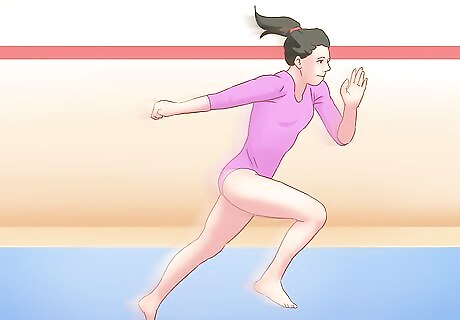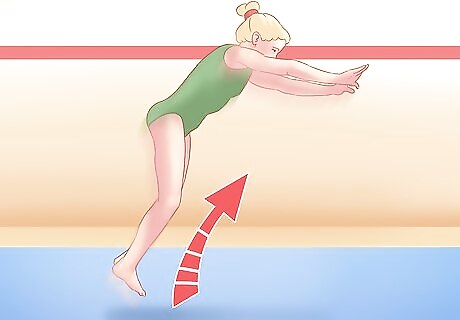
views
Starting Your Front Tuck

Have some basic moves down first. The first would be a somersault; preferably, you’ll be able to do several in a row. Next, and probably the most useful to learn, would be a front handspring. Both the somersault and handspring get you used to being upside down in the air. Practice both until you’re totally comfortable before moving on to the front tuck. You’ll also need to be relatively in shape to do a successful front tuck. Flexibility is also a great help. Try doing a handstand, either free or against a wall; if that is too much physical exertion for you, you might want to reconsider taking on the front tuck. If you haven't mastered these other moves, do not attempt a front tuck. The front tuck is a serious move that requires advanced gymnastic skills. If you attempt it too soon, it may lead to injury.

Find a safe space. Ideally, you’ll be performing your first front tuck in a proper gymnasium with padded mats on the floor and walls. If you can help it, do your best to seek out a gymnasium in which to train if only to be sure of your own safety. For those without access to a gymnasium, consider using a carpeted room (at the very least) or someplace outdoors with very full grass. Be sure to find a spot well away from any walls. There’s a chance of you falling to the side, or falling forward or flat at the end. You’ll want to reduce any chance of colliding with a wall (especially if they are not padded) by keeping clear. Have someone with you in case you hurt yourself. While it’s unlikely you’ll be seriously injured in the course of attempting a front tuck, it’s never a bad idea to have someone else monitoring, just in case.

Get a running start. While you won’t need room to get full speed, step back four or so paces from the spot you hope to jump from to begin your flip. You’ll need to take a few quick steps forward to begin your flip. These steps will provide you with the forward momentum you’ll need to complete your front tuck. Facing the direction you’d like to perform your flip, take three or four quick steps forward. For these steps, stay bouncy by stepping with your toes, heels in the air. On the last step (before you jump with both legs) jump lightly as best as you can with whatever foot you end with (try having it be your dominant one). Again, step using the front of your feet so that you have a spring to your steps. Raise your arms above your head as you bounce to begin to prepare for the flip Lean slightly forward during these initial steps before the jump; the added weight forward will help with your flip.

Jump up at a slight forward angle. After your last bouncy step, land hard with both legs. Land with your toes as with the running steps just taken; you’ll need the bounce that it will provide. You’ll want to jump up as high as you can, but don’t bend your knees low to get power. Jump as high as you can using your toes with your knees only slightly bent. You’ll jump straight up, but you’ll keep your shoulders leaning forwards and your arms up above your head, tilted slightly forward. Your arms and shoulders will drive the flip motion of your front tuck. This may very well be the step that needs the most repeating. The most common problem for those on their first attempts will be a lack of jump height. If you find yourself unable to complete the front tuck on your feet, keep working at your jump or try on a trampoline surface.

Position yourself in the air. Once in the air, begin swinging your upper body forward. Your arms should follow, beginning to move down (almost perpendicular to your chest) to tuck in your legs. Keep your back straight as you move; the temptation to curve it inwards may be strong. Tilt your head so that it looks to the ground. This is useful both for orienting yourself during your flip, but it puts your head forward along with your shoulders to help drive the motion of the front tuck.
Completing Your Front Tuck

Tuck your legs. To perform the signature motion of the front tuck, you’ll need to bring your knees to your chest in order to form a sort of ball. In terms of timing, you’ll want to begin the tuck just as your torso first becomes parallel with the ground after your jump (you’ll be facing the ground). Bring your arms down to your knees and tuck them in tightly. Your chest should make good contact with your thighs and knees. Using a loose hold for this could cut your jump short, and have you landing other than on your feet. Be sure to move your knees to your chest with some force, both to have them in place quickly and to add that much more momentum. By the time your torso is perpendicular with the ground again (with your head closest to it), your knees should be tightly tucked into your chest by your arms. Keep your head neutral and in line with the rest of your back, which should be straight.

Bring your legs out of the tuck. Once your torso has swung forward some more and is now parallel with the ground again, begin to move your legs away from your chest. For a good timing indicator, this is when your head will be facing the ceiling or the sky. Your arms should come away from your legs, but don’t fling them backwards. You want to provide as little force possible in the direction opposite your front tuck. Instead, relax them at your sides. Like your arms, don’t force your legs outwards; keep them relaxed at an almost right angle to your body. Imagine the seated position, but laying on your back. This will position your feet to catch your body after the last turn. As in the previous step, keep your head relaxed and in line with the rest of your back. You may begin to tilt it forward as you finish your rotation in order to have a better look at where you’re landing.

Land on your feet. Though a front tuck requires a blind landing, you should have some sense of the ground if you’ve tilted your head forward into the final rotation. If everything in the front tuck has gone as it should, you should simply land on your feet without issue. Right as you land your knees should be bent into a right angle (formed by calf and thigh); pop up with your back straight and arms above your head for a showy finish. There’s a good chance in your first tries that you’ll under-rotate. Be sure not to try to put your arms out behind you to catch yourself; you’re likely to hurt them instead. It’s better to do your best and rotate to land flat on your back or side. If you over-rotate, do your best to re-tuck your legs and roll out of it, either forward or to the side. Depending on where you come out, you may need to put your arms out to avoid landing on your head.

Troubleshoot to get it just right. If at all possible, try using a friend or coach as a spotter to help you learn the moves. Have the spotter rest both hands gently on either side of your abdomen. Then, they’ll move with you as you execute your front tuck. The spotter will have a much better perspective on what went wrong (if anything), so it's useful to have someone involved to help with troubleshooting. Again, the most common problem will be to lack jump height. Fortunately, this will be fairly obvious when it’s the case; you’ll find yourself unable to complete the flip on your feet, landing instead on your side or bottom. Nothing more to do in this instance than practice and work on leg strength (your calves in particular). Another common problem with those first trying the front tuck will be to untuck their legs either too early or too late. This is an issue that’s a little more simple to notice with a spotter or someone watching. Try practicing tucking/untucking on the ground (on your back) to get a sense of the speed at which to do it (it’ll be faster than you think).




















Comments
0 comment